Logan Square, also referred to as Logan Circle, is a public square on the Benjamin Franklin Parkway. The square is bordered by stately buildings, but the highlight is the beautifully sculptured Swann Memorial Fountain.
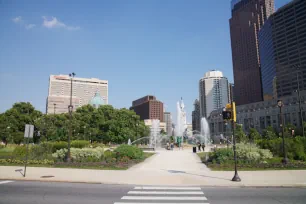
Originally, Logan Square was known as Northwest Square, one of the original five squares on William Penn’s 1682 plan for Philadelphia. It was used both as a burial ground and for public executions. The last person was hanged here in 1823.
Logan Circle
In 1825 the square was renamed Logan Square after James Logan, William Penn’s secretary. In the early twentieth century, a traffic circle was created in the middle of Logan Square as part of the development of the Benjamin Franklin Parkway. Ever since, Logan Square has also been known as Logan Circle, although in the strict sense the latter designation refers to the traffic circle only.
Jacques Gréber, who designed the new parkway, based his plans for Logan Square on the Place de la Concorde in Paris. Gréber envisioned a tall monument at the center of the traffic circle, similar to the obelisk on the Place de la Concorde.
Swann Memorial Fountain
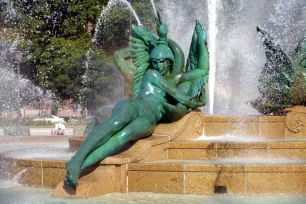
Instead, a large fountain was created by the Philadelphia Fountain Society in honor of its late president and founder Dr Wilson Swann. The Swann Memorial Fountain of the Three Rivers was built in 1924 by Wilson Eyre, Jr. and sculptor Alexander Stirling Calder, whose father had designed the William Penn Statue on the Philadelphia City Hall.
Eyre designed the central jet, which propels the water 50 feet / 1.5 meters in the air. The jet is surrounded by three allegorical figures representing Philadelphia’s principal waterways. Calder sculpted the Schuylkill as a mature woman, the Wissahickon Creek as a girl and the Delaware River as a man.
Surrounding Buildings
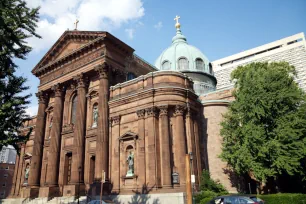
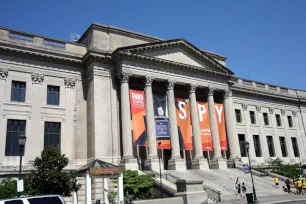
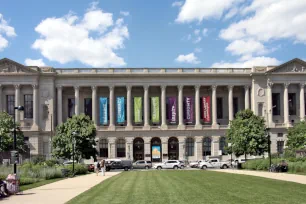
Logan Square is surrounded by a number of important institutions, all of which are housed in stately buildings.
The oldest building and most impressive landmark bordering Logan Square is the Cathedral of Saints Peter and Paul, a brownstone structure with a Palladian facade. The church was built between 1846 and 1864 and is particularly known for its magnificent interior in Italian Renaissance style.
Opposite the cathedral, on the west side of Logan Square, sits an equally grand and even more imposing edifice that is home to the Franklin Institute, the oldest science museum in North America. It was built in 1929-1931 to a classical revival design created by the local architect John Torrey Windrim.
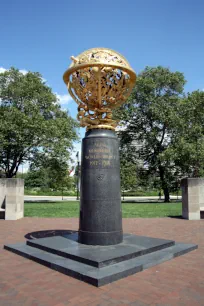
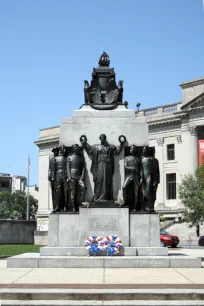
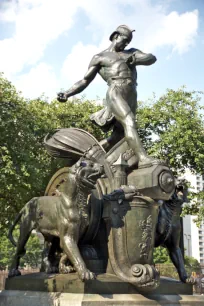
On the other side of the square is the Free Library of Philadelphia, which has been located here since 1927. The library building was designed by Horace Trumbauer in the classical revival style and features a long colonnaded front facade which terminates on either side in classical temple fronts. Its design is mirrored in the adjacent courthouse building from 1941.
There’s another museum on Logan Square: the Academy of Natural Sciences, a natural history museum that borders the square to the south. The museum building dates from 1876 and originally had a Victorian Gothic design, but in the early twentieth century it was drastically modified into a Beaux-Arts style building.
Memorials
There are quite a few interesting memorials in and around Logan Square.
In the middle of a small plaza in front of the Franklin Institute is the Aero Memorial, a gilded bronze celestial sphere that rests on a tall black pedestal. It was created in 1948 by Paul Manship, who is best known for his Prometheus statue at Rockefeller Center, and honors Philadelphia aviators who perished during World War I.
Nearby is another war memorial: the All Wars Memorial to Colored Soldiers and Sailors. This memorial was created by Jakob Otto Schweizer, a Swiss-American sculptor, and was dedicated in 1934 when it was erected in Fairmount Park. In 1994, it was moved to its current, more visible location. The memorial shows an urn with an eternal flame guarded by four eagles and set on a granite base flanked by bronze figures.
Across the Benjamin Franklin Parkway stands another monument: the Shakespeare Memorial, created in 1928 by Alexander Stirling Calder as a tribute to the great English playwright William Shakespeare. Calder sculpted two characters from Shakespeare’s play: Hamlet, who represents tragedy and Touchstone, who represents comedy.
Towards the east, in front of the courthouse, is the memorial to Galusha Pennypacker, a Union general during the American Civil War. The American sculptor Charles Grafty started with the creation of the dramatic monument, but after he died in 1929 his compatriot Albert Laessle took over and completed the memorial in 1934. The bronze monument shows the general in a heroic pose standing on top of a gun carriage flanked by two tigers.

